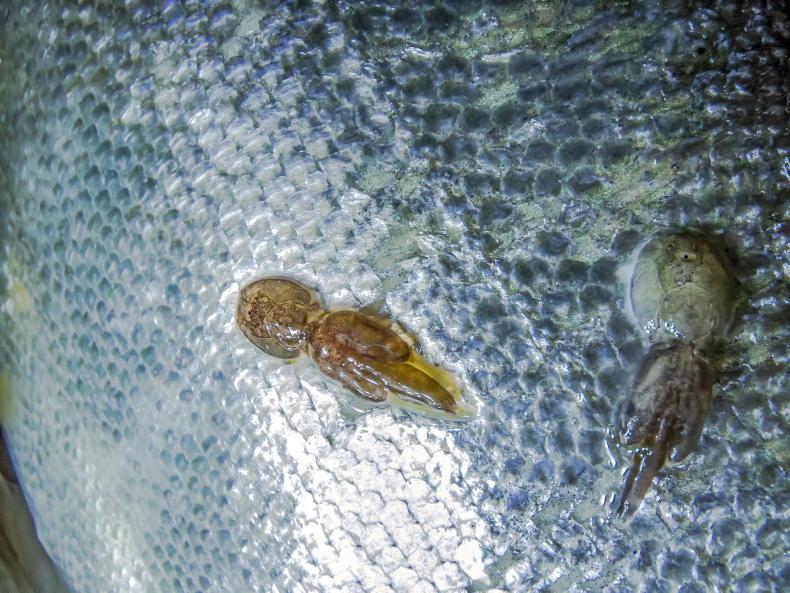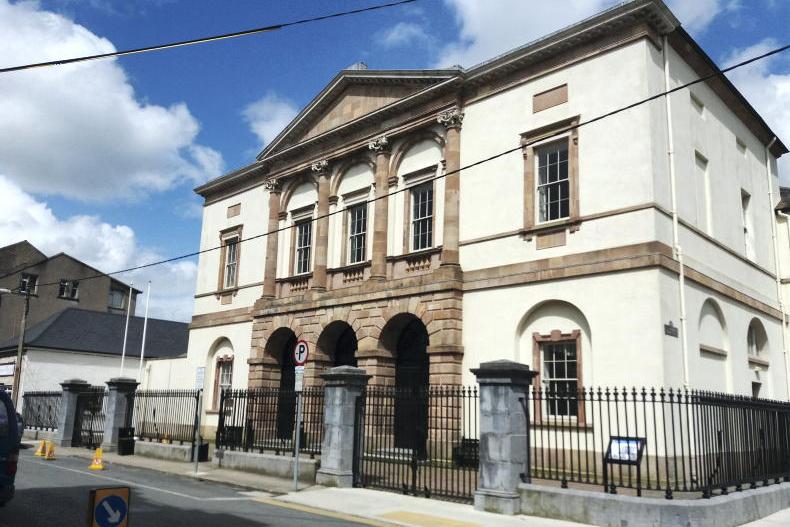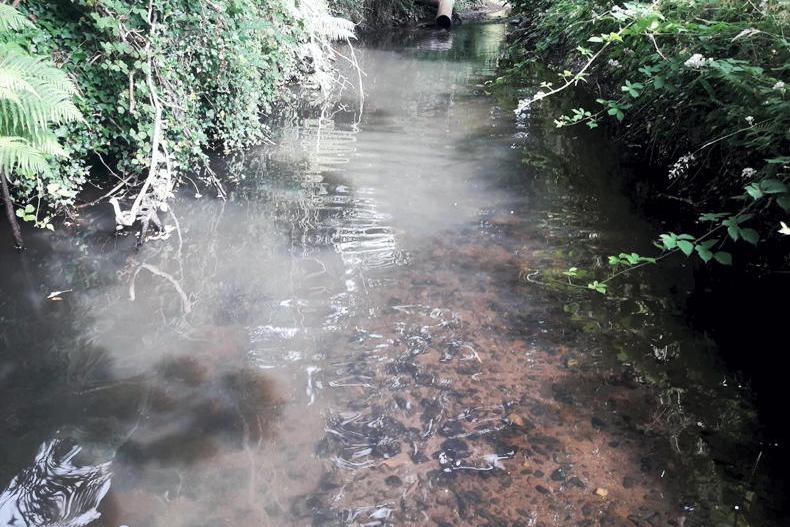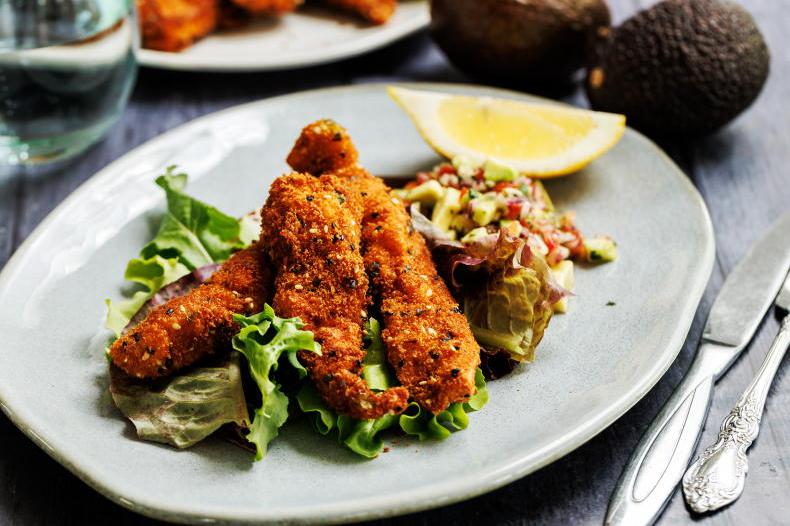Wild salmon are an anadromous species. This means they spend parts of their lives in fresh water (rivers) and salt water (for Irish salmon, the North Atlantic Ocean). You will find salmon in Irish rivers during certain stages: as eggs and young fish, and then later as adults, as they return to the same river to lay eggs of their own (spawn).
Since we have better access to rivers, we have a good working knowledge of how river-based problems (like agricultural run-off, engineered barriers and habitat disruption) can affect their overall survivability.
We don’t have as good an understanding of what happens when they’re at sea, or why fewer salmon make it back to Irish rivers to spawn each year. Research indicates that much of the mortality we see in wild salmon occurs during this “marine phase” of their life cycle.
Many believe that, over the years, salmon farming has had a detrimental effect on wild salmon and sea trout populations through mismanagement, pollution and parasites or disease. It’s true – salmon farming has gotten a bad reputation over the years – but is it really the main culprit in declining wild salmon numbers?
Inland Fisheries Ireland
Dr Michael Millane, a senior research officer with Inland Fisheries Ireland (IFI), tells Irish Country Living that there are a range of pressures in river, coastal and marine environments for wild salmon stocks. He says all of these pressures can be (directly or indirectly) attributed to human activities and their marine survival rate is the biggest factor in reduced Irish salmon populations.
“Survival at sea has declined from 15-20% of juveniles returning as adults to Irish rivers in the 1970s and 1980s to a current level of around 5%,” he explains. “This has been attributed to factors such as climate change, which has had a negative impact on natural ecosystems that salmon at sea rely on to survive.”
As sea temperatures rise, it is understood that wild salmon must travel further to reach their feeding grounds. As they are sensitive to changes in water temperature, it is believed this longer journey has contributed to their increased mortality while at sea.
In terms of coastal pressures, Michael says salmon farms are a problem for wild populations. As smolts (young salmon) enter the ocean, they often pass coastal salmon farms and are susceptible to parasites known as sea lice.
Sea lice
Two types of sea lice can be found on wild salmon. They attach themselves to the fish and feed on their mucus, blood and skin. According to the Marine Institute (Ireland’s State agency responsible for marine research, technology development and innovation), they are naturally occurring and would originally be found on fish returning to Irish rivers after their oceanic journey.
However, sea lice infestations on salmon farms are now a cause of concern as they attach themselves to younger, smaller salmon who are just beginning that journey. Michael tells Irish Country Living there is a large body of peer-reviewed international studies which have documented negative effects of salmon farming on wild fish populations.
“There is increased marine mortality on wild salmonids due to sea lice infestation associated with open-net salmon farms, which can substantially reduce the number of fish that would otherwise return to spawn in the stocks affected,” he says. “[Aside from the sea lice issue], interbreeding of escaped farmed salmon with wild salmon poses a threat to the sustainability of affected wild stocks. IFI does support the sustainable development of the aquaculture industry in Ireland – [but] the word ‘sustainable’ is key and specifically encompasses sustainability of the development from an ecological, as well as financial, point of view.”
Marine Institute
Irish Country Living reached out to the Marine Institute for further information. A representative confirms the overall number of wild salmon stocks has fallen significantly in recent decades during their “marine phase”, and that sea lice infestations can affect their marine survival rates. However, they say the impact of sea lice from salmon farms is “highly variable.”
“Over the last number of decades, concerns have been raised that sea lice have been negatively impacting wild salmonid populations and this has been the subject of intense research and scientific debate,” they say.
“Marine Institute studies, performed between 2001 and 2009 at eight locations along the west coast of Ireland, showed this to be the case in some instances, but overall ‘the combined data suggest that while sea lice-induced mortality on outwardly migrating smolts can be significant, it is a minor and irregular component’.”
In other words, these studies indicate that sea lice alone are not a significant cause of wild salmon mortality during their time at sea. The representative says that Norwegian trials (performed between 1996 and 2011) also found evidence that sea lice contribute to the mortality of Atlantic salmon during outward migration, but this mortality is also dependent on other factors.
“In a more recent study, the same authors stated: ‘Our data support the hypothesis that the impact of parasites on Atlantic salmon is context-dependent,’” the representative says. “And furthermore, ‘it is not possible to accurately predict marine survival conditions for salmon’.”
Monitoring programme
Ireland’s National Sea Lice Monitoring Programme was first introduced in 1991 and has been managed by the Marine Institute since its induction. All active marine farms are inspected 14 times per year on a fortnightly basis from March to May, and on a monthly basis from June to February, with all data published in an annual report (available to view on marine.ie). The Marine Institute operates under the Department of Agriculture, Food and the Marine (DAFM). In correspondence with Irish Country Living, a department representative says their monitoring programmes are “comprehensive,” with annual environmental surveys carried out on each site.

Sea lice.
“All operational marine finfish farms are also inspected annually by the Department’s Veterinary Inspectors for compliance with fish health regulations. In addition, all active marine finfish sites are inspected annually by the Department’s Marine Engineering Division.”
Better alternatives?
There are alternative options to open-net coastal salmon farm operations which could potentially solve these issues while producing high-quality salmon for food.
Re-circulating aquaculture systems (known as RAS) are land-based farms which can raise Atlantic salmon (and other types of seafood) in a highly controlled environment. It is reported that, in these systems, farmed fish are raised in a higher welfare environment (due to increased protection from disease and contamination) while coastal environments are left untouched.
Re-circulating systems filter and reuse most of their water, with filtered fish waste making ideal fertiliser for other types of farming. These farms appear to have a beneficial environmental effect; working within a circular, low-waste system.
RAS farms are currently in operation or in development in other countries (like Iceland, the US and Canada). They require investment and take time to develop, but Michael (from IFI) feels this is the type of salmon farming we should be doing in Ireland. “The area of particular concern to IFI is the need to ensure that any aquaculture development does not have a deleterious effect on other important sectors [such as the valuable salmon and sea trout tourist angling sector] while enabling us to fully comply with our national and international environmental and conservation obligations to protect wild fish,” Michael says.
“IFI favours the development of closed containment re-circulatory land-based systems for the farming of Atlantic salmon, as this ensures all outputs can be sustainably managed and controlled without affecting wild fish.” CL
The Irish Farmers Association (IFA) Aquaculture Committee reached out to Irish Country Living
with the following statement regarding Irish aquaculture, and particularly Irish salmon farms: “The Irish aquaculture industry provides essential employment opportunities for rural coastal communities with almost 2,000 direct jobs and over 15,000 indirect jobs in seafood processing and marine ancillary services sectors. Irish aquaculture produce is worth €196m in production value, the majority of that value (€124m) coming from Irish organic salmon, according to the latest BIM Business of Seafood 2022 publication.
“Ireland is the only producer of organic salmon in the EU, with 100% of Irish farmed salmon certified to organic standards. [This means] organic salmon [have] special diets containing only organic ingredients from sustainable sources, with fish meal and oil derived from the trimmings of fish caught for human consumption; sourced from Irish by-product suppliers.
“All aquaculture operators implement fish health management plans; they require them to outline their fish health management practices including biosecurity and fish welfare. The aquaculture sector complies with obligations, particularly environmental objectives, outlined in a number of policies and regulations [ie Habitats Directive, Birds Directive, Consolidated Environmental Impact Assessment Directive, Marine Strategy Framework Directive, Marine Spatial Planning Directive, Water Framework Directive and the Common Fisheries Policy].
“Under the current licensing system, the aquaculture sector is required to comply with more environmental legislation than any other sector in the marine space.
“The IFA has launched a new, industry-focused policy guide entitled ‘Best Practice Guidance & Information on Aquaculture Licensing, Legislative Responsibilities & Environmental Objectives.’ The guide, developed by IFA Aquaculture in conjunction with Aquacence consulting, is a comprehensive resource on licensing and environmental objectives for those operating in the sector. This best-practice guidance aims to bring wider awareness and knowledge of the aquaculture licensing process in Ireland [there is an online version available].”
Read more
Minister McConalogue must administer €20m fund for Irish aquaculture
Irish aquaculture sector can benefit coastal communities with correct policies
Wild salmon are an anadromous species. This means they spend parts of their lives in fresh water (rivers) and salt water (for Irish salmon, the North Atlantic Ocean). You will find salmon in Irish rivers during certain stages: as eggs and young fish, and then later as adults, as they return to the same river to lay eggs of their own (spawn).
Since we have better access to rivers, we have a good working knowledge of how river-based problems (like agricultural run-off, engineered barriers and habitat disruption) can affect their overall survivability.
We don’t have as good an understanding of what happens when they’re at sea, or why fewer salmon make it back to Irish rivers to spawn each year. Research indicates that much of the mortality we see in wild salmon occurs during this “marine phase” of their life cycle.
Many believe that, over the years, salmon farming has had a detrimental effect on wild salmon and sea trout populations through mismanagement, pollution and parasites or disease. It’s true – salmon farming has gotten a bad reputation over the years – but is it really the main culprit in declining wild salmon numbers?
Inland Fisheries Ireland
Dr Michael Millane, a senior research officer with Inland Fisheries Ireland (IFI), tells Irish Country Living that there are a range of pressures in river, coastal and marine environments for wild salmon stocks. He says all of these pressures can be (directly or indirectly) attributed to human activities and their marine survival rate is the biggest factor in reduced Irish salmon populations.
“Survival at sea has declined from 15-20% of juveniles returning as adults to Irish rivers in the 1970s and 1980s to a current level of around 5%,” he explains. “This has been attributed to factors such as climate change, which has had a negative impact on natural ecosystems that salmon at sea rely on to survive.”
As sea temperatures rise, it is understood that wild salmon must travel further to reach their feeding grounds. As they are sensitive to changes in water temperature, it is believed this longer journey has contributed to their increased mortality while at sea.
In terms of coastal pressures, Michael says salmon farms are a problem for wild populations. As smolts (young salmon) enter the ocean, they often pass coastal salmon farms and are susceptible to parasites known as sea lice.
Sea lice
Two types of sea lice can be found on wild salmon. They attach themselves to the fish and feed on their mucus, blood and skin. According to the Marine Institute (Ireland’s State agency responsible for marine research, technology development and innovation), they are naturally occurring and would originally be found on fish returning to Irish rivers after their oceanic journey.
However, sea lice infestations on salmon farms are now a cause of concern as they attach themselves to younger, smaller salmon who are just beginning that journey. Michael tells Irish Country Living there is a large body of peer-reviewed international studies which have documented negative effects of salmon farming on wild fish populations.
“There is increased marine mortality on wild salmonids due to sea lice infestation associated with open-net salmon farms, which can substantially reduce the number of fish that would otherwise return to spawn in the stocks affected,” he says. “[Aside from the sea lice issue], interbreeding of escaped farmed salmon with wild salmon poses a threat to the sustainability of affected wild stocks. IFI does support the sustainable development of the aquaculture industry in Ireland – [but] the word ‘sustainable’ is key and specifically encompasses sustainability of the development from an ecological, as well as financial, point of view.”
Marine Institute
Irish Country Living reached out to the Marine Institute for further information. A representative confirms the overall number of wild salmon stocks has fallen significantly in recent decades during their “marine phase”, and that sea lice infestations can affect their marine survival rates. However, they say the impact of sea lice from salmon farms is “highly variable.”
“Over the last number of decades, concerns have been raised that sea lice have been negatively impacting wild salmonid populations and this has been the subject of intense research and scientific debate,” they say.
“Marine Institute studies, performed between 2001 and 2009 at eight locations along the west coast of Ireland, showed this to be the case in some instances, but overall ‘the combined data suggest that while sea lice-induced mortality on outwardly migrating smolts can be significant, it is a minor and irregular component’.”
In other words, these studies indicate that sea lice alone are not a significant cause of wild salmon mortality during their time at sea. The representative says that Norwegian trials (performed between 1996 and 2011) also found evidence that sea lice contribute to the mortality of Atlantic salmon during outward migration, but this mortality is also dependent on other factors.
“In a more recent study, the same authors stated: ‘Our data support the hypothesis that the impact of parasites on Atlantic salmon is context-dependent,’” the representative says. “And furthermore, ‘it is not possible to accurately predict marine survival conditions for salmon’.”
Monitoring programme
Ireland’s National Sea Lice Monitoring Programme was first introduced in 1991 and has been managed by the Marine Institute since its induction. All active marine farms are inspected 14 times per year on a fortnightly basis from March to May, and on a monthly basis from June to February, with all data published in an annual report (available to view on marine.ie). The Marine Institute operates under the Department of Agriculture, Food and the Marine (DAFM). In correspondence with Irish Country Living, a department representative says their monitoring programmes are “comprehensive,” with annual environmental surveys carried out on each site.

Sea lice.
“All operational marine finfish farms are also inspected annually by the Department’s Veterinary Inspectors for compliance with fish health regulations. In addition, all active marine finfish sites are inspected annually by the Department’s Marine Engineering Division.”
Better alternatives?
There are alternative options to open-net coastal salmon farm operations which could potentially solve these issues while producing high-quality salmon for food.
Re-circulating aquaculture systems (known as RAS) are land-based farms which can raise Atlantic salmon (and other types of seafood) in a highly controlled environment. It is reported that, in these systems, farmed fish are raised in a higher welfare environment (due to increased protection from disease and contamination) while coastal environments are left untouched.
Re-circulating systems filter and reuse most of their water, with filtered fish waste making ideal fertiliser for other types of farming. These farms appear to have a beneficial environmental effect; working within a circular, low-waste system.
RAS farms are currently in operation or in development in other countries (like Iceland, the US and Canada). They require investment and take time to develop, but Michael (from IFI) feels this is the type of salmon farming we should be doing in Ireland. “The area of particular concern to IFI is the need to ensure that any aquaculture development does not have a deleterious effect on other important sectors [such as the valuable salmon and sea trout tourist angling sector] while enabling us to fully comply with our national and international environmental and conservation obligations to protect wild fish,” Michael says.
“IFI favours the development of closed containment re-circulatory land-based systems for the farming of Atlantic salmon, as this ensures all outputs can be sustainably managed and controlled without affecting wild fish.” CL
The Irish Farmers Association (IFA) Aquaculture Committee reached out to Irish Country Living
with the following statement regarding Irish aquaculture, and particularly Irish salmon farms: “The Irish aquaculture industry provides essential employment opportunities for rural coastal communities with almost 2,000 direct jobs and over 15,000 indirect jobs in seafood processing and marine ancillary services sectors. Irish aquaculture produce is worth €196m in production value, the majority of that value (€124m) coming from Irish organic salmon, according to the latest BIM Business of Seafood 2022 publication.
“Ireland is the only producer of organic salmon in the EU, with 100% of Irish farmed salmon certified to organic standards. [This means] organic salmon [have] special diets containing only organic ingredients from sustainable sources, with fish meal and oil derived from the trimmings of fish caught for human consumption; sourced from Irish by-product suppliers.
“All aquaculture operators implement fish health management plans; they require them to outline their fish health management practices including biosecurity and fish welfare. The aquaculture sector complies with obligations, particularly environmental objectives, outlined in a number of policies and regulations [ie Habitats Directive, Birds Directive, Consolidated Environmental Impact Assessment Directive, Marine Strategy Framework Directive, Marine Spatial Planning Directive, Water Framework Directive and the Common Fisheries Policy].
“Under the current licensing system, the aquaculture sector is required to comply with more environmental legislation than any other sector in the marine space.
“The IFA has launched a new, industry-focused policy guide entitled ‘Best Practice Guidance & Information on Aquaculture Licensing, Legislative Responsibilities & Environmental Objectives.’ The guide, developed by IFA Aquaculture in conjunction with Aquacence consulting, is a comprehensive resource on licensing and environmental objectives for those operating in the sector. This best-practice guidance aims to bring wider awareness and knowledge of the aquaculture licensing process in Ireland [there is an online version available].”
Read more
Minister McConalogue must administer €20m fund for Irish aquaculture
Irish aquaculture sector can benefit coastal communities with correct policies











SHARING OPTIONS